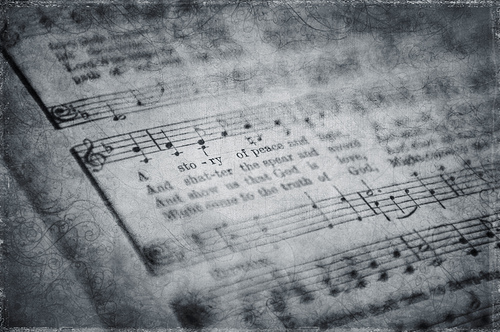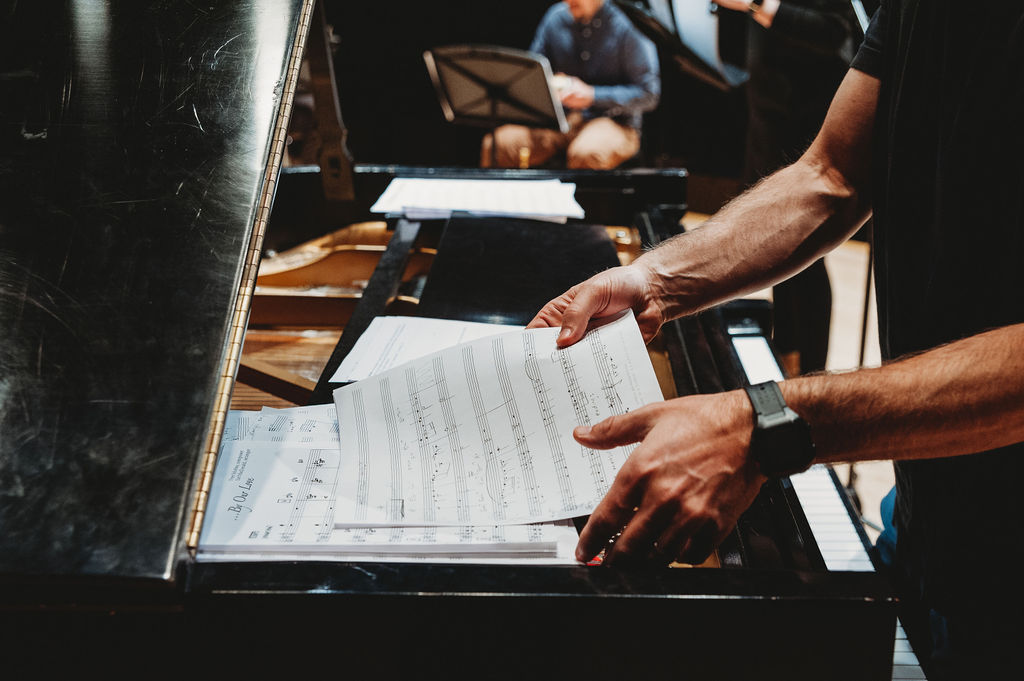I’ve been asked, “Why did you record an album of old hymns? What led you to arrange these liturgical songs and undertake this project?” My answer might not be as straight-forward as you’d expect. My attitude towards traditional hymnal singing is actually riddled with ambivalence. Calling it a love-hate relationship might border on melodrama, but there’s some truth in this characterization.
Conflicting Feelings
My long-drawn-out, conflicted relationship with hymns dates back to my childhood. I was probably 8 or 9 years old when I joined the regular rotation of organists at Ness Baptist Church in Winnipeg, Manitoba. (It wasn’t until high school that I switched over to mostly playing the piano.) I can’t say I loved hymns back in the day. To be honest, I found them old-fashioned and repetitive. However, there was a blind pianist in my church, Garry Varty, who did considerably more with these pieces than the rest of us. I’d listen to him intently and would try to copy his pianistic fills and harmonies. His playing opened up a world of possibilities to me as a young musician.
My Dad has always loved hymns too. He was never a great pianist, but he could approximate his way through almost any hymn on our living room spinet piano. Bagpipes are his main instrument. He even wrote a series of books called “The Church Piper,” where he transposed hymns for the bagpipes. I used to accompany him on the organ on the occasions when he played at church. So, hymns were very much a part of my childhood and upbringing, and they evoke some nostalgia within me.
But candidly, for me and many other musicians with whom I have spoken, congregational singing, led by well-meaning amateur musicians, sometimes feels akin to being poked with knitting needles, rather than being a means through which to enter a state of worship or contemplativeness. With this album, I wanted to create a rejuvenating spiritual conduit for musicians and connoisseurs of art music to experience peace and enter into an ethereal, sacred mindset. I also wanted to express a wide spectrum of sentiments, ranging from reverence and gratitude to petition, pleading and lament. In doing so, I sought to remedy the singular thematic expression of joy that is overused contemporary worship music. There is so much more to life and our interrelation with God. Why not express this diversity of experience in corporate singing?
Creative Expression
As an arranger, I gravitate towards songs with beautiful, memorable melodies. More often than not, hymns fit this criterion perfectly. Some of my earliest musical arrangements and experimentations with chord substitutions were with hymns. There is a satisfaction I find in taking something old and tastefully modifying and reinvigorating it, and to accentuate its original beauty. In this way, one might compare what I do to antique furniture restoration; or to use a repeated Biblical metaphor, bringing something dead back to life. Aestheticism is one reason why I engage in perking up tired hymns. I have written dozens of hymn arrangements. Some date back more than 30 years. With most of them, I can remember the exact church, and musicians with whom the arrangement was first played.
Addressing A Crisis of Faith
I have many good memories of growing up in the church, but my faith at age 51 is very different from what it was at age 15, 21, or 35. As I have matured, my understanding of the scriptures is considerably less black and white. I have grown more comfortable with ambiguity and questioning some of the scriptural interpretations taught to me in my youth. I’ve seen both the good and the indelible harm church communities and Christian organizations have caused. When I read about droves of people leaving the church, I get it.
The entanglement of the church in politics, the rise of the Christian Nationalist movement, and the unwavering evangelical support of Trump are amongst the most spiritually disorienting things I have experienced in my entire journey of faith. My brooding arrangement of “They’ll Know We Are Christians By Our Love” conveys the sense of betrayal I have felt by my former tribe. The piece and its corresponding animated short video subtly point out how far adrift the Christian boat has sailed. Without the compelling need to share this piece publicly, I may never have released the other pieces on this album. I wanted to raise questions, make a statement and get people talking.
The off-putting and unloving behavior of self-professed Christians has left my faith with some scars and bruises. Doubts have resurfaced as I question where I belong, how I fit in, and the extent to which I wish to disassociate myself from the church. Declaring myself an ex-Christian was my initial inclination, but this didn’t sit right with me. I question lots of things within the Bible, and wrestle daily with my faith. However, I don’t feel personally conflicted about the counter-culture teachings of Jesus. My issues are more with the layers of culture which have packaged, sold and accepted as Christianity.
Grappling with Powerful, Poetic Lyrics
 Although I’ve sung and played hymns for years, I had never carefully scrutinized the poetic lyrics. Curiously, when putting together this album, my faith was somewhat bolstered as I examined the lyrics from my earlier hymn arrangements. Reading and considering the words to “Take My Life and Let It Be Consecrated,” for example, prompted a question: Was I truly “all in” or was I “out?” And if I was “all in,” how could more fully embrace the process and journey of not withholding anything from God?
Although I’ve sung and played hymns for years, I had never carefully scrutinized the poetic lyrics. Curiously, when putting together this album, my faith was somewhat bolstered as I examined the lyrics from my earlier hymn arrangements. Reading and considering the words to “Take My Life and Let It Be Consecrated,” for example, prompted a question: Was I truly “all in” or was I “out?” And if I was “all in,” how could more fully embrace the process and journey of not withholding anything from God?
It dawned on me; if re-examining these “played out,” old songs helped rekindle my smoldering faith, maybe my updated renditions could help others re-experience the efficacy of these songs. I like the metaphor of staging an old painting within a new frame with proper lighting, to facilitate seeing for the first time what was in front of us all along.
Going Beyond Self-Interest
Hymns provide a connection to our pasts while speaking to our present circumstances. One might experience a sense of peace through knowing our grandparents’ grandparents sang these songs. On the occasions when I’ve volunteered to play hymns in senior centers, I’ve seen residents’ faces light up. Those who barely utter a word start singing along. Obviously for many, there is a deep connection to songs like “Be Still My Soul.” These hymns seem to offer comfort and reassurance.
I do most of my praying as I walk. Before committing myself fully to this project, I walked and prayed. I asked God to use this music in ways beyond what I could imagine, for His purposes. I didn’t want this album to be about me or about further proving my musicianship. In my mind, this project needed to be about something deeper than that. Now that the music is arranged, recorded and about to be released, my prayer persists.
In considering my audience, I realize that for some, this album might be a memory-evoking, nostalgic connection to their past. Others will simply experience these songs as carefully arranged, yet unfamiliar, beautiful melodies. Proselytizing is not my intent here; but, I believe my spiritual connection to the material brought the music to a perceptively higher level. Regardless of any listener’s religious leanings, I hope this album will be spiritually uplifting and heartening for those who take the time to listen.

